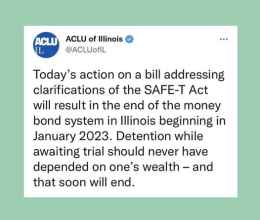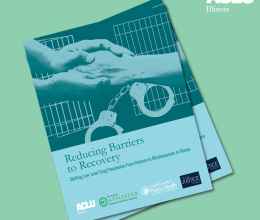
Illinois still sends too many people to prison - and gives too many people felony records that follow them for life - for crimes that are often just the symptoms of poverty, addiction, and mental illness. Like a young woman in Chicago, who had her dreams of a career in medicine dashed after pleading guilty to simple drug possession. Or a teenager facing the prospect of prison after being caught stealing a winter coat from a Target store.
Even after a person finishes their sentence, having a felony record means that they will continue to face severe stigma, including numerous restrictions on access to employment, housing, education, and other crucial resources. These consequences are concentrated in segregated low-income neighborhoods, further deepening the existing patterns of inequality and disinvestment.
Over the past three decades, at least 1.5 million people have been convicted of felonies in Illinois. Many of these Illinoisans became entangled in the criminal legal system as a result of possessing small amounts of drugs or for property offenses like shoplifting—crimes often related to addiction and other mental health issues. From 2016 to 2018 alone, more than 5,000 people went to prison in Illinois for low-level thefts that would be categorized as misdemeanors in most other states. During this time, about 20,000 people were convicted of felonies for small-scale drug possession in Illinois, with more 7,500 going to prison.
But Illinois jails and prisons are not treatment centers. Police, prosecutors, and judges are fundamentally ill-equipped to manage complex health conditions. Even the most well-intentioned people working in criminal courts and correctional facilities usually lack the training, support, and resources to adequately respond to the specific needs of people with substance use disorders and other mental health issues.
Among people in Illinois jails and prisons, it is estimated that only 17 percent of those in need of clinical treatment services actually receive those services during their incarceration. While these numbers are abysmal, they are consistent with national averages.
Incarceration ultimately worsens the health outcomes of individuals who are at increased risk of death from overdose and suicide after their release. When people are already struggling with an addiction or health issues, the experience of going to jail only further destabilizes their lives, exacerbates the economic pressures they face, and stigmatizes them as criminals for life.
Incarceration also places stress on entire families and traumatizes children by taking their parents out of the home. Women represent a growing percentage of Illinois’ incarcerated population, usually because of retail theft or drug possession convictions. Incarcerated women are more likely to have been convicted of a low-level offense than their male counterparts and are also more likely than men to have been convicted of drug crimes: 30 percent vs. 18 percent. Of the approximately 2,500 women imprisoned in Illinois, about 80 percent are mothers and approximately 65 percent of their children are minors.
To reduce the number of people who become entangled in the legal system because of poverty and untreated health conditions, we must first start by ending the failed War on Drugs. To shift away from criminalization and embrace a public health and harm reduction approach to drug use and possession, Illinois must:
- Reduce the sentence classification for all drug crimes by at least one class and reclassify simple possession of any controlled substance from a felony to a misdemeanor.
- Eliminate mandatory minimums and sentencing enhancements based on prior criminal history for drug offenses.
Illinois must also modernize its outdated sentencing laws for property crimes. From 1975 through 2009, Illinois’ felony retail theft threshold remained unchanged at $150, even though the cost of goods quadrupled during that time. Since then, the cost of goods has continued to rise, but the threshold has increased just once and has not kept pace with inflation.
Today, retail theft is a felony in Illinois if the stolen goods have a value of just $300 or more, and even someone stealing a sandwich can face felony charges if they have a prior misdemeanor theft conviction on their record.
Those thresholds make Illinois an outlier, putting us out of step with every other state in the Midwest and most other states in the country. Only two states have a lower felony threshold. 29 states have thresholds of $1,000 or above, and several have thresholds of $2,000 or even $2,500.
While opponents have warned that raising the threshold might embolden thieves and cause theft to rise, evidence from other states shows that is not the case. A study of 37 states that raised their felony theft thresholds between 2000 and 2017 found that raising felony thresholds has no impact on the rates of theft or overall property crime, and the amount of a state’s felony theft threshold—whether it is $500, $1,000, $2,000, or more—is not correlated with its property crime and larceny rates.
Illinois should follow the lead of these 37 states and pass legislation to:
- Increase the felony threshold for retail theft from $300 to $2,000; and
- Repeal the penalty enhancement that requires a misdemeanor charge to be upgraded to a felony if the person has any prior theft conviction.
With these actions, the State of Illinois can work towards keeping more people out of its overcrowded prison and jail systems – especially in an ongoing pandemic – and give people a better chance at getting the treatment and help they need, instead of exacerbating the problem by throwing them behind bars.






